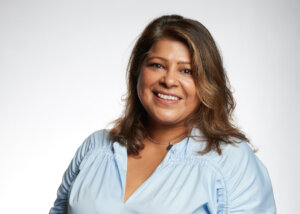Women in tech: building a more inclusive future

|
Getting your Trinity Audio player ready...
|
In Part 1 of this article, we spoke to Shalini Palmer, Corporate Vice President, EMEA at Analog Devices, about her long career in tech, and some of the experiences faced by women in tech, both 30 years ago and today.
Shalini gave us some insight into the importance of role models, but also mentioned some practical ideas of changes that could be made to help get – and keep – women in tech for long-term careers.
She explained how vital it is to get girls interested in STEM subjects very early to capture their imaginations, and gave advice based on her own process at Analog about how to tweak the interviewing procedure so as not to actively discourage women from applying for jobs in tech.
Next, we asked her, once women were in the door of the tech industry, how we could keep them in it, given statistics that show that of the women who make it in (just 27% of those employed in the industry), a full 50% of them leave it by the time they’re 35.
SP:
Flexibility is massively important. We have to accept that women with careers have babies. We have parents that we have to care for, and of course, I’m hoping that we’ll evolve to a world where there is more equity and equality in how we do those things, but the reality is that having a flexible employer is important for women.
Alongside this element, showing people the opportunities and different career paths that can be taken and really getting people excited about the vast opportunities electronics engineering has to offer is necessary.
Making it real.
Sometimes, people think electronics engineering is not for them, but if you start to equate electronics engineering with the real world elements that play into the job, such as humanity, the planet and the environment, suddenly you’re including everyone. Female engagement in these roles is essential – they’re 50% of the population and technology benefits from their perspectives.
Such engagement in technology is particularly critical as we move more towards AI and machine learning. Stanford University suggests all of the research and data that’s been collected for these models over the last two decades shows gender bias and even racial bias.
THQ:
We’re going out on a limb here, but we’d be willing to bet there’s also heteronormative bias in there too…
SP:
Well, yes, probably. So we need to be careful as these AI and machine learning models are being built to make decisions. To remove gender bias in technology, women need to be heard and need to be part of creating and informing this new age of technology.
THQ:
Definitely.
How do we make that happen?
SP:
For women to be at the table, we have to figure out how we attract them. I mentioned in Part 1 an undergraduate student I know. In her class of 100, there are only seven women in the electronics engineering course. We need to move faster to get women interested in this.
But this interest cannot then be neglected when we have them in the organization – you have to be intentional about their development. You’ve got to make sure that you are not waiting to be asked. Instead, you need to make sure you are asking them (and this is for the men and the women who are leaders, who are hiring managers), being much more intentional about how diverse your teams are. There’s enough data and statistics out there to point to more diverse teams being more successful.
The power of intention.
THQ:
OK – but how do we measure that intentionality?
SP:
Your intention is shown in how you give feedback, especially between a male manager and a female employee. There’s this whole thing of “I don’t want to hurt her feelings.” So, make sure that as a woman, you are asking for feedback – fact-based feedback – so you always have an understanding of what it is you need to do to get to that next level.
THQ:
Or at the very least, what is said about what you need to do to get to that next level.
SP:
I am currently mentoring somebody ready for a promotion in one group, but who now is being told they aren’t quite ready. So I asked them if they understood what it is they need to do, and she said, “No, I don’t.” That’s why you need to ask “What are the next steps that I need to take to be able to take that promotion?”
READ NEXT

Women in tech: inequality dissected
Much more support for women is needed in that journey to the next promotion, and keeping an open flow of communication is vital. However, alongside this cycle, we need that flexibility we talked about.
Just because you go off and you have a baby, you’re still there, so as managers, we need to make sure that we’re able to support you and have the patience to look at the long-term contribution that women can make to the workplace – otherwise we lose them.
THQ:
We lose 50% of them. That feels like a bleak indictment of the industry as it stands.
Avoiding unnecessary losses.
SP:
If women feel that they’re disadvantaged or they’re overlooked for promotions because they have a baby, if they’re not able to get flexibility in their working environment, they will look for alternative areas in which to work. So we have to work very hard to support women through these cycles.
THQ:
Do we still need to change the perception of what electronics engineering actually is? And possibly how we sell it to girls and young women?
SP:
Back in the day, my parents were horrified when I said I wanted to go into engineering. They said it was dirty. It was “not a job for a girl.” That is still relevant today, yes.
I think a genuine concern is if you pick a field where you’re not seen and heard, how are you going to progress? Why would you pick an area which is twice as hard as some others? Everyone has a responsibility to encourage women and change how we sell the courses in a way that highlights career progression.
My friends’ daughters all say that in their schools they’re missing a whole chunk of information on what’s out there. We aren’t using the information that we have at our fingertips!
Focus on the impacts.
I work for a company that’s looking to make tomorrow even better than it was today, through innovation, through technology, and you look very proudly at the contributions that you make to enable those things, but the industry as a whole needs to take more responsibility for how we enable and how we connect things that people can really relate to, from a technology engineering innovation perspective.
We lose a lot of people who study engineering to consultancy, banking and finance, and we need to start making sure that rewards and recognition are there for people that choose careers in engineering. Then it’s about holding this up as a profession that is essential and needs highly intelligent, capable people.
THQ:
And as you were saying, we need to translate things like electronics engineering from a flat and abstract concept into the impacts it can have on the world, and on a changed and improved future.
SP:
For women, this is massive. Women (generally) tend to be innately nurturing; we want to do something better. So the minute you start talking about the healthcare innovation or the impact on the environment, the connections between the engineering and the impact suddenly get women excited about engineering.
Changing everything – because everything needs changing.
THQ:
Is it fair to say we’re looking to change more or less everything in society, in terms of education, in terms of the law, in terms of things like childcare provision?
SP:
We need a huge amount of change, yes. Everybody knows about innovation – we heard all about it through the pandemic. People are aware of how important innovation and technology is in everyday life and in absolutely everything we do, so we need to ensure there is an equal voice included here.
To do so, we have to turn everything on its head, in every aspect of education, society, governments, social media and media overall.
THQ:
It feels like this should be obvious to everyone. And yet, in terms of the provision in the pipeline, we’re still dealing with, at best, 20th century structures and concepts, that are still forming an unequal playing field.
SP:
Exactly.
If we don’t get this right, we’re going to base our future on an extremely narrow representation of society. We all have a responsibility to make sure that there is broader representation, including of all genders, ethnicities and neurodiversities. The issue is that we really aren’t thinking about how we represent our society.
We have to break these traditions and break these barriers. I’m very proud that I have the opportunity to run Europe for my company. I am the first woman in a company that is 60 years old to have that honor. And I feel a huge responsibility to make sure that I’m able to bring some of the change that we talked about.
We are setting ourselves targets in terms of how we increase the female population and the female management population. We’re also looking at the black Hispanic and Latin populations in the US. Overall, we need to be more intentional.
So I’m very proud to be in a position where I’m able to think about these things and see how I can connect with other industry leaders and institutions to really start to bring some change. I’m really proud to say that almost 50% of our graduate intake is now female. Now my job will be to make sure that I can retain and develop them.

Shalini Palmer, Corporate Vice President EMEA at Analog Devices.









